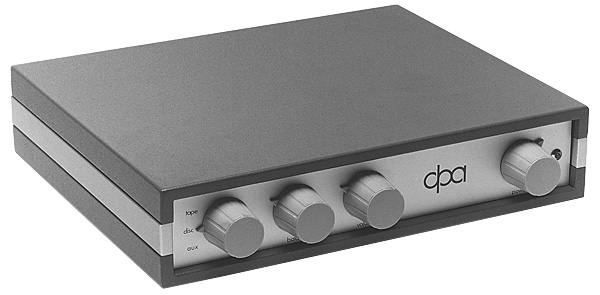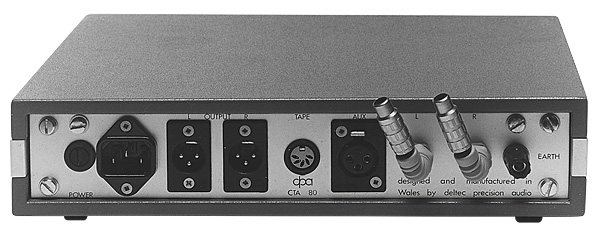British pre-conceptions (August 1985) Page 2
Soundstaging was more than satisfactory, and stage depth was ample enough to remind listeners that there is a 3D nature to stereophonic reproduction. Meanwhile, imaging was rock solid, with all performers located precisely within the stage. lt was this area of performance that best forged links between this product and those costing much more; a less tangible aspect of the MVT's nature keeps it from being a British equivalent of the Krell PAM-3.

Animal Rock
One friend of mine calls it 'energy', another 'power', and – to borrow the phrase from an American colleague – I think of it as 'moxie'. But let's use the vernacular and call it 'wellie'. While the MVT handled music of a subtle and delicate nature with aplomb, it sounded a bit thin when fed something of a primal nature. You don't get much more savage than the heavy metal of Mountain and the MVT lacked a bit of the weight necessary to convey the juggernaut nature of animal rock. This, however, will worry few HFN/RR readers, who show, by a wide margin, that they prefer the sweet strains of classical to the unbridled power of rock.
Where this leaves Wagner fans is anybody's guess, but I'd have to say that the MVT should prove thrilling for those who like the Quad ESL-63s for the right reasons though it will not win the hearts of JBL fanciers. The MVT offers sound notable for its precision and refinement, without seeming clinical. If you want some raunch on occasion, you might try the...
Deltec CTA 80
Costing £660 including leads, this preamp screams 'purist' from every angle. Like the MVT, the CTA 80 is a no-nonsense design calculated to do as little to the signal as possible. Its minimalist facilities comprise only an on-off switch, volume and balance controls, and a selector choosing either disc, tape, or auxiliary. The rotary on-off control is positioned on its own, over to the right, and more than once I reached for it as if it were the volume control. Silly me...

The back of the amp is pure XLR, the only concession to domestic audio traditions being the inclusion of RCA phono sockets on protected flying leads. However, you needn't worry about doing any soldering, as the cost of this unit includes the correctly terminated leads for your own requirements. Deltec's seemingly out-of-the ordinary concern for leads stems from its involvement with recent developments in single-strand/solid-core cables and this carries over to the internal wiring. I stuck with my trusty Monster Cable lnterlink Reference A signal cables and Powerline 2 speaker cables in order to minimise the changes in my system during the listening sessions.

High-End Cred
The phono stage, with passive RIAA equalisation, doesn't go through the source selector switch, being 'on' at all times. Breakthrough will occur if a disc is playing when either of the line inputs are in use, but then, who listens to two sources at once? Our sample of the amp was delivered with the factory-set MC stage (100ohm impedance, 120µV sensitivity), though MM or other MC settings can be ordered. The phono input is not user-variable.
The CTA 80 worked beautifully in my system, though it was immediately apparent that the MVT was the quieter unit. I don't want to blow this all out of proportion, because the MVT's silence well beyond the norm, and the CTA 80's ambient noise was but the merest whisper of hiss, way below what's deemed acceptable for valve units and better than average for fine solid-state offerings.
Comparisons, in fact, have little bearing on this piece, as the CTA 80 is so different in nature that the potential buyer for either will have no difficulty in choosing between them. For all their similarities – minimalist nature, a price difference of only £140 (not a lot in this upper-market sector), adherence to purist ideals – the overall character of the two preamps creates a polarity that prevents either from competing with the other.
The CTA 80 and the MVT are soulmates in the ways that they convey speed and dimensionality; the former is a solid-state virtue, the latter a valve virtue (at least that's the way my thermionically-addled brain sees it). There is a certain 'rightness' that the CTA 80 possesses which speaks volumes for its high-end credibility that is immediately evident, a sense also imparted by the MVT, which says 'we're 90% there'. (Over-the-top designs like the Audio Research SP-10 say 'we're 95% there'.) But there is only one right path, and the CTA 80 veers towards it in a slightly different direction than does the MVT.
Carry That Weight
As I said above, the MVT should appeal to those who crave finesse and delicacy. The Deltec CTA 80 chooses another route, and goes for the power. Yes, we have here a pair of preamps that represent both sides of the same coin, one fine and dry, the other rich and rousing. lf the MVT is a Piesporter, then the CTA 80 is Bull's Blood.


















































